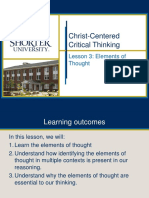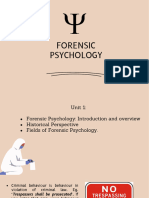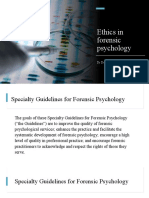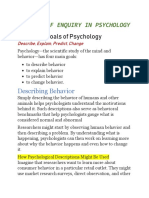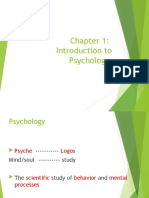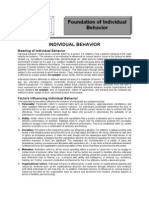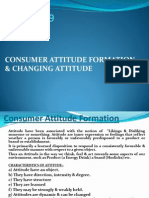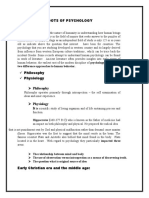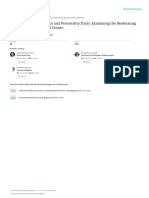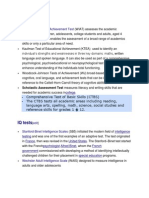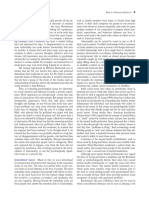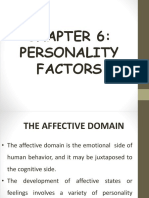Personality Exam Notes
Personality Exam Notes
Uploaded by
paolynne123Copyright:
Available Formats
Personality Exam Notes
Personality Exam Notes
Uploaded by
paolynne123Original Description:
Original Title
Copyright
Available Formats
Share this document
Did you find this document useful?
Is this content inappropriate?
Copyright:
Available Formats
Personality Exam Notes
Personality Exam Notes
Uploaded by
paolynne123Copyright:
Available Formats
Personality Notes
1-Introduction to Personality
What is Personality?
The scientific study of the whats, whys, & hows of human motivation, thought, attitude, &
behaviour (question-understand-control)
The scientific study of personality has its focus on individual differences and attempts to
understand the person as deeply, completely, and precisely as possible (Shoba & Mischel, 1996)
Personality psychology *is+ the broadest of all psychological disciplines, one that attempts to
understand both human nature and the ways in which individuals differ (Buss, 2007)
Defining Personality
The person as a character
o e.g. the coward, the flatterer, the fool, etc.
Personality as temperament (characteristic reaction patterns)
o Melancholic, choleric, sanguine, & phlegmatic
o Stock characters & the commedia dell arte
o e.g. the handsome hero, the pretty young maiden, the jealous husband, etc.
o Personality as social attractiveness
o Persona: The mask
o Per (il) suono: To sound (through)
o Popularity, attractiveness, ability to impress & get along with other people
Scientific Definition of Personality
A psychological construct
Personality represents those characteristics of the person that account for consistent patterns of
behaviour (Pervin, 2009)
The dynamic & organised set of characteristics possessed by a person that uniquely influences his
or her cognitions, motivations, & behaviours in various situations (Ryckman, 2007)
Personality structures:
~ The most stable and enduring aspects of personality.
Personality processes:
~ Dynamic motivational concepts (conscious or unconscious).
e.g. efforts to reduce tension or efforts to achieve growth and self-fulfilment.
Nomothetic vs. idiographic approaches to personality inquiry
Nomothetic- Of or relating to the study or discovery of general scientific laws; a tendency to generalize,
and is typical for the natural sciences. It describes the effort to derive laws that explain objective
phenomena in general.
Idiographic- relating to or involving the study of individuals; a tendency to specify, and is typical for
the humanities. It describes the effort to understand the meaning of contingent, unique, and
often subjective phenomena.
Personality Theory
Personality is a science (well )
o Not implicit personality theories
o Not just common sense
o Astrology (ha! Yeah!)
o Personality structures
o The most stable and enduring aspects of personality
Personality processes/expressions (the way you view the world)
o Dynamic motivational concepts (conscious or unconscious)
e.g. efforts to reduce tension or efforts to achieve growth and self-fulfilment
Personality expressions (the way you view the world)
o Aggression-hostility, criminality
o Optimism/pessimism, anxiety
o Physical appearance
o Mental health/disorder
Personality determinants
o Environmental determinants: family, education, culture, etc.
o Biological determinants: brain functions, nervous system, hormones, age, etc.
o Genetic determinants: heritability, genes, evolution, etc.
http://webspace.ship.edu/cgboer/perscontents.html
2-Psychoanalytic and Psychodynamic Approaches to Personality
Psychoanalysis and Freud
Without hesitation, I place Freud among the heroes. He dispossessed the Jewish people of the
greatest and most influential of all heroes Moses (Salvador Dali)
Freud *+ descended to the Underworld and met there stark terrors. He carried with him his
theory as a Medusas head which turned these terrors to stone (R.D. Laing)
Christians of discernment should avoid *psychoanalytic therapies+ completely. *+ Such therapies
stand upon dogma *+ and the dogma is the odious one of Freud and his followers (M. & D. Bobgan
in Prophets of Psychoheresy I)
As far as the unconscious was concerned, Freud went down deeper, stayed longer, and came up
dirtier than anybody else (G. Allport)
I am reminded of something my father said when he spoke of how we bring up our children. He
said we supply them with a map of the Italian lakes and send them to the North Pole (Anna Freud)
No one who *+ conjures up the most evil of those half-tamed demons that inhabit the human
beast, and seeks to wrestle with them, can expect to come through the struggle unscathed. *+
Incidentally, why was it that none of all the pious ever discovered psycho-analysis? Why did it have
to wait for a completely godless Jew? (Sigmund Freud)
Assumptions in Psychoanalysis
Psychic determinism: Everything that happens in a persons mind has a specific cause
The cause lies in the structure and dynamics of personality
The purpose of psychoanalysis is to find those causes, by digging deep into the hidden part of the
mind
Mind: The psychological result of what the brain & the rest of the body do
Levels of awareness
o Conscious: the content of ones awareness at any given point in time
o Preconscious: material just beneath awareness that are easily retrievable
o Unconscious: greatly influential material, such as memories and desires, that a person is not
consciously aware of
o Collective unconscious: latent memory traces (archetypes) inherited from peoples ancestral
past
Internal structure: The mind consists of specific functionally independent, and at times conflicting, parts
Id (aka It): The irrational and emotional part of the mind
o Pleasure principle: The need of an immediate gratification of Ids urges (raw biological
desires)
Ego (aka I): The rational and decision-making part of the mind
o Reality principle: The force that delays the gratification of the Ids needs until the
appropriate conditions are present
Superego (aka Over-I): The moral part of the mind
Psychic conflict: The friction between the different parts of the mind
The egos main job is to find a middle course (a psychic compromise) between the competing
demands of motivation, morality, and practicality
The most important of these conflicts centre on sexual or aggressive impulses
o Without reasonable internal compromises the individual is faced with an internal conflict
between their needs and impulses that can have disastrous results (mental illness, criminal
behaviour)
Prolonged and unresolved conflict between the parts of the mind (can) lead to considerable levels
of anxiety and/or guilt
o The ego is anxious about
the Id getting out of control and doing something terrible
the Superego getting out of control and making you feel guilty (about things you did
or thought or desired)
Definition Example
Repression Keeping distressing thoughts and
feelings buried in the unconscious
A traumatized soldier has no
recollection of the details of a
close brush with death
Projection Attributing ones own thoughts,
feelings, or motives to another
A woman who dislikes her boss
thinks she likes her boss but feels
that the boss doesnt like her
Displacement Diverting emotional feelings
(usually anger) from their original
source to a substitute target
After parental scolding, a young
girl takes her anger out on her
little brother
Reaction Formation Behaving in a way that is exactly
opposite of ones true feelings
A parent who unconsciously
resents a child spoils the child
with outlandish gifts
Regression A reversion to immature patterns
of behavior
An adult has a temper tantrum
when he doesnt get his way
Rationalization Creating false but plausible
excuses to justify unacceptable
behavior
A student watches TV instead of
studying, saying that additional
study wouldnt do good anyway
Identification Bolstering self-esteem by forming
an imaginary alliance with some
person or group
An insecure young man joins a
fraternity to boost his self-esteem
Mental energy- The energy that the mind requires to function (equivalent to personality processes)
Consists of two fundamental drives (motives):
o Libido or life drive or sexual drive: a motive towards
o Thanatos (death): a motive towards destruction creation, protection, enjoyment of life,
productivity and growth, disorder, and ultimately death
Personality Development
Psychosexual stages- developmental periods with a characteristic sexual focus (urge for physical pleasure)
that shape ones personality
Stage Approximate Age Erotic Focus Key Tasks and Experiences
Oral 0-1 Mouth (sucking, biting) Weaning (from breasts or bottle)
Anal 2-3 Anus (expelling or retaining
feces)
Toilet training
Phallic 4-5 Genitals (masturbating) Identifying with adult role models;
coping with Oedipal crisis
Latency 6-12 None (sexually repressed) Expanding social contacts
Genital Puberty onwards Genitals (being sexually
intimate)
Establishing intimate
relationships; contributing to
society through working
Fixation- the failure to move forward from one stage to another due to excessive gratification or
frustration of needs at a particular stage
Stage of Fixation Personality Qualities
Oral Incorporative: Dependent, gullible, jealous
Sadistic: Sarcastic and verbally aggressive
Anal Expulsive: Messy, cruel, destructive
Retentive: Obstinate, neat and orderly, stingy
Phallic Among males: Macho, aggressive sexuality, excessive striving for career power,
sexual and occupational impotence
Among females: Flirtatious, seductive behavior that doesnt lead to sexual
interaction
Contribution of Psychoanalysis
First proper personality theory
First theories to propose the existence and the influence of unconscious processes and forces
Major contributions to the treatment of (primarily) anxiety and mood disorders
o E.g. Dream therapy
o Clinical hypnosis
o Free association
Criticism
Poor testability
Inadequate empirical evidence
Sexism
Function more like philosophies or faith systems
3- Cognitive and Behavioral Approaches to Personality
Cognitive behavioral (CB) objections to the approaches to personality (2
nd
approach)
The clinical approach (psychoanalysis theorists)- observing people with mental health problems
Flawed- how can we really know what is going on in ones mind, if we cannot directly observe and
measure it?
Doesnt allow for generalization (cohort/ sample/selection biases)
Lack of standardization
Cant generalize across cultures
Theoretical Approach (aka armchair speculation)- Observations in a variety of situations
Limited to certain cases
Conclusions may be biased/subjective (issues with deductive premises)
Lack of standardization or scientific bases
Assumptions in CB
Behaviorism- claims that the only valid way to know a person is through directly observing their behavior
(B-data). We can only know what we can sense, and we sense everything we need to know.
Personality is the sum of behaviors (including neurophysiological functions)
The causes of personality can be found in the individuals environment (i.e. they can be directly
observed)
The goal of behaviorist is functional analysis that maps out how exactly behavior is a function of
ones environmental situation
Learning- the change in behavior as a function of experience
Personality (change) is a result of learning
o Give me a dozen healthy infants, well formed, and my own specified world to bring them up
in and Ill guarantee to take any one at random and train him to become any type of
specialist I might select- doctor, lawyer, artist, merchant, chief, and yes, even beggarman and
thief, regardless of this talents, penchants, tendencies, vocations, and race of this ancestors
(Watson, 193) -Stress on being a healthy baby and controlling environment
According to radical behaviorism
o Personality doesnt really a priori exist
o Environmental contingencies can shape the person into anything and anyone
o Personality is the end product of our habit systems
o It is more or less fixed by the age of 30
Main types of learning
Habituation (becoming used to a stimulus)- the process through which the intensity of behavioral
responses to repeated stimuli declines through time
o The stimulus needs to be: repetitive, within a given range of time-intervals, within a given set
of parameters
Conditioning
o Classical-learning by association
Learned helplessness -response to unpredictable stimuli that leads to chronic
anxiety and possibly depression
Fear vs. anxiety- fear is a response to a condition or stimulation that you expect
through knowledge or conjecture that the outcome is bad, anxiety is an approach
mechanism of alertness- psychological response to certain arousal
Pavlov
o Operant -learning through reinforcement or punishment
Behavioral hedonism -we are primarily motivated to learn in order to seek pleasure-
reward -and avoid pain punishment
o Social-learning through observing and imitating others (Bandura?)
Authority/role modeling and live relevance
Same behavior-some/similar response to the same stimuli
Matched-dependent (simple) behavior -blindly following a model
Copying (complex) behavior
Social learning is mediated by ones self efficacy (ones perception and cognition of
their capabilities)
Contribution
First objective personality theories
The first truly scientific theories of personality
The first theories to point out the major effects the environment has on personality
Major contributions to treatment of primarily phobias, substance abuse, personality, and mood
disorders
o CBT
o Systematic desensitization
o Aversion therapy
o Rational emotive therapy
Criticism
Deterministic (plus originally dehumanizing)
o Denies the existence or effects of choice
o Contrast with reciprocal determinism the idea that the relationship between a persons
behaviors and personality is bidirectional
Overdependence on animal research
Do not really propose a personality structure
(Originally) simplistic
o All we are is learned
o Our personality is a direct response to environmental stimuli (+situationalism- the
approach that we dont have underlying traits, we just react to situations)
o Only or mainly observed behavior is personality
o Largely tend to neglect unobservable thoughts, aspirations, emotions, unconscious
processes, attitudes, biology
Famous theorists
John Watson (1878-1958)
Burrhus Skinner (1904-1990)
George Kelly (1905-1967)
John Dollard (1900-1980)
Neal Miller (1909-2002)
Albert Bandura (1925- )
Walter Mischel (1930- )
Zimbardo, Bandura, Pavlov
4- Humanistic and Existential Approaches to Personality
Psychoanalysis (1
st
force in psychology)
o Negative (pessimistic) view of personality
o Downplays the role of consciousness
o Focus on the unconscious
Behaviourism (2
nd
force in psychology)
o Simplistic (reductionist)
o Mechanistic
o Ignores subjective experiences
o Ignores the existence/role of consciousness
Both approaches are deterministic
Assumptions of the Humanistic and Existential Approaches to Personality
Focus on the creative potentials inherent in humans
Seeks to help individuals realise their highest and most important goals (growth & psychological
health)
Emphasis on the dignity and worth of humans and the conscious capacity to develop competence
and self-respect
Focus on:
o The good side of human nature (Humanism)
o Existence (dasein = being-in-the-world)
o The now and here and on such things as: love, affiliation, creativity, spontaneity, joy,
courage, humour, independence, morality, and personal growth
Each human being is a unique individual (idiographic approach)
Humans are good and (should) always strive to be happy (optimistic view)
Freedom to choose ones own behaviour and control (responsibility) over ones life:
o How you act (freedom of doing)
o What you become (freedom of being)
o If you are to be self-actualized or accept conditions of worth
Personality a unified whole and inseparable from the physical, psychological, and social environment- The
whole is greater than the sum of its parts
Existence of innate (personality) growth mechanisms
The growth process is the drive towards:
o Self-actualisation
o Self-realisation
o Selfhood
Total personality development is achieved when we realise and utilise in full our abilities and
potentialities
Society (the bad guy) restricts personal growth through its rules and laws
Obedience to (social) rules leads to dull, conventional, mediocre, and submissive individuals
Realisation of the individuals potentialities if environmental conditions are right
Rejects the medical model of mental illness. Illness is a result of
Incongruence (aka incongruity)
o Disharmony within cognitive elements of experience
o Discrepancy between ones experiences and their self-concept
Leads to anxiety
Can cause low self-esteem
(Rational) distortion of experience
D-Needs (deficiency needs)
o Physiological, safety, love, esteem
Failure to satisfy them can lead to (mental) health problems
Terror management (awareness of and response to death)
o Nothingness vs. being
o Existential guilt and angst
Contribution
The first holistic personality theories
The first theories of personality to capitalise on subjective (free) will, personal responsibility, and
conscious choice
The first non-deterministic theories of personality
They gave rise to positive psychology, transpersonal psychology (the 4
th
force), and holistic
approaches to medicine
Major contributions to social care systems, humanitarian interventions, and the treatment of
(primarily) substance abuse and relational problems
o E.g. Person-Centred Therapy
o Gestalt Therapy
o Logotherapy
o Conjoint Family Therapy
Criticism
Society is bad, individuals are good
What is conventional is mediocre
Too much reliance on the individuals self-reported conscious experience
Methodology is often too vague, unscientific, and untestable
Theories lack falsifiability
o Qualitative research methods more suitable
Famous Theorists
Gordon Allport (1897-1967)
Abraham Maslow (1909-1970)
Carl Rogers (1902-1987)
Rollo May (1909-1994)
5- Psychobiological and Lexical Approaches to Personality
Assumptions of the Traits Approach
Personality is the dynamic & organised set of characteristics possessed by a person that uniquely
influences her or his cognitions, motivations, attitudes, behaviour, and psychobiology as a whole
Personality exists! (heuristic realism)
Personality is a probabilistic and dynamic system
Personality has both quantity and quality properties
Systematically describes differences and similarities between (and within) individuals, across time
and space
Emphasises the need of a useful scientific taxonomy
Personality develops through the interplay between:
Cognition -memory, perception, thought, language, intelligence
Temperament -characteristic, biologically-based reaction patterns, present from an early age
Constitution or physiology -neurology, endocrinology, genetics, etc.
Environment -both human and physical
The building blocks of personality are called traits
Traits are general dispositions that people possess that uniquely influence their psychobiology
o E.g. outgoing, impulsive, anxious, sociable, hostile, optimistic, altruistic
Every human possesses all traits, but not at the same intensity or centrality
Their (major) development is assumed to end in early adulthood
They are relatively stable over time and situation
o Traits vs. States
Personality is dimensionally and hierarchically arranged
The Hierarchical Arrangement of Personality
How does the traits approach discover personality?
(Common) assumptions:
The personality space is made up of dimensions
These dimensions tend to be independent from each other
These dimensions are finite
We can discover these dimensions by decomposing the personality matrix!
Statistics
Factor analysis
Two Main Trait Typologies
The Lexical taxonomy (the Big-5)- seeks to identify personality trait-descriptors in natural language
Neuroticism: Emotional stability
Extraversion: Having a degree of social impact
Agreeableness: Maintaining positive relations with others (quality of interpersonality)
Conscientiousness: Responsibility, morality, and will to achieve
Openness: Artistic tendencies, intellect, being open to new ideas or change
The Psychobiological taxonomy (the Big-3)- seeks to identify the biological/genetic markers of personality
traits
Neuroticism (related temperament: emotionality)
A predisposition to mood and anxiety disorders
Extraversion (sociability and impulsivity)
A predisposition to accidents and injuries
It mediates the psychopathological effects of the other two dimensions
Psychoticism (tough- vs. tender-mindedness)
A predisposition to psychotic disorders
Contributions
Scientific theories that are evidence-based
Clear-cut predictions
Testable
Cross-cultural validity
Occupational/educational psychology
Psychopathology (the foundation of Clinical Psychology)
Evolutionary (personality) psychology, behavioural genetics, & Animal psychology
Forensic psychology, criminal profiling & adaptive interrogation techniques
Criticism
How many traits or dimensions?
Heavily dependent on statistics
Heavily dependent on self-reports
When assessment is based on medical methods it is impractical
Actually, do traits exist at all?
Main Trait Theorists
Gordon Allport (1897 - 1967)
Raymond Cattell (1905 - 1998)
Hans Eysenck (1916 - 1997)
Jeffrey Alan Gray (1934 - 2004)
Marvin Zuckerman (1928 - )
Kim Bartholomew (?)
Claude Robert Cloninger (1944 - )
Theodore Millon (1928 - )
Cindy Hazan (?)
David Buss (1953 - )
Samuel Gosling (?)
6- Personality Assessment
Opens with example on female psychopaths- theyre easier to spot and survive less as its not
evolutionarily adaptive
General Types of Personality Assessment put this in a table
Tests of performance Internal states are hidden and cannot be revealed, but expressions of
internal states can be used.
o Attempt to reveal the intent or (expressions of) internal mental states of a person
Mental abilities tests, IQ tests, Psychomotor tests, response latency
o There are problems with ecological validity
The expression of traits arent the same as they are in real life
These tests control for many variables (noise) to provide a clear measure of
personality, but in real life there are too many variables and often things occur as a
result of chance
Behaviour observations- look at how you act in real life, very different from tests of performance
o Assessment of typical manifestations of an attribute within a specific context
(Semi- unstructured) Interviews, Participant-observations (ethnography)
Ethnography- overlaps with cross-cultural studies, participating and observing an
event (usually covert)
o The problem of replicability
Self (peer)-reports- most common approach
o Self-reported assessment of ones own (or their peers) feelings, attitudes, beliefs, values, etc.
Personality tests, Standardised (clinical) interviews, surveys
o The problem of dishonesty
Impression formation- you want to make a good impression on whoever is evaluating
you
People know how to manipulate test
Psychophysiological assessment
o Measuring biological functions that relate to personality
E.g. fMRI scans, EEG data, GSR data, PET scans, blood tests, gene sequencing
o The problems of reductionism and practicality
It is reductionist but not in personality
Steps for Scoring (Quantifying) Your Personality
Collect data- established rules for scoring & obtaining quantitative information from behaviour
samples
o You then do an analysis of these results (expert assessment etc.)
Objective scoring
o E.g. Standardised (Clinical) Questionnaires
Subjective scoring
o (psychologists judgement)
o E.g. Vignette, Projective, and role-playing tests
Concerns Regarding the Interpretation of Test Results Important for exam
Are the observed attributes real?
o (Cultural) test biases
o Procedural /administrative biases
o Faking
o Framing and observer biases- Anxiety is universal but the labelling of anxiety is different
o Anxiety- does an indication of anxiety represent someones real levels of anxiety
o Variations of personality
Are the observed attributes important?
o The difference between statistical and practical (psychological) importance
Do tests help or hurt?
o The person as a number
o The issue of labelling- connotations with labels
Psychometric Properties of Personality Tests
Validty-the degree to which a test measures what it claims to measure- if something measures
depression, how does it measure depression
o The appropriateness or meaningfulness of test scores or interpretations
E.g. IQ scores- how can you use it to have real life implications
o The degree to which measurements or observations are a true representation of reality
How good of a snapshot of the persons self does the test give
Reliability- the degree of consistency or stability of measurement scores across time or context
o The absence of measurement fluctuations that are unaccounted by the measurements
scope
o An individual should consistently produce similar responses to any test that measures
the same personality elements
Personality factors change. With depression you need to track changes, but in
most cases tests are static
Reliability vs. Validity
A valid measure always hits the target; a reliable measure always hits the same place on the
target
o Something can be valid and reliable, valid unreliable, and invalid but reliable (it hits in the
same space but far off the topic- something is present but you cant be sure what), and
invalid and unreliable
Reliability is a necessary but not sufficient condition for validity
At the conceptual level, a valid measure is always reliable
Exam
16 questions, 4 choices, only 1 correct
Read Chapter 12 of the textbook (lectures may contradict book, follow the lecturer)
All Qs and their answers can be found in the lectures notes and delivery
Example questions
o According to Jun, the Collective Unconscious is
o In Mays theory, Terror Management refers to
o Eysenck claims that Personality Traits are
Personality Theorists and their Main Theories
Anna Freud
S. Freud Psychoanalysis, see above.
A. Freud
(1895-1982)
More interested in dynamics of psyche than structure (esp. ego)
Ego Psychology
Looked at defense mechanisms.
Worked with children and adolescents
Problems with analyzing children (still have parents, need to avoid being another
authoritative figure, children may have difficulty relating emotional difficulties)
Children could be monitored in relation to their peers
Standardized records for children with diagnostic profiles, encouraged long time
observation, led way for use of natural experiments (groups of children with similar
disabilities)
Erik Erikson
(1902-1994)
Concerned with identity
Was a Freudian ego-Psychologist (accepted Freuds ideas as basically correct) but more
society and culturally orientated
Epigenetic principle- we develop through a predetermined unfolding of our personalities
in eight stages. Progress through each stage is determined by success or lack of success in
all previous stages
Each stage involves tasks/crises. They have a certain optimal time. If each stage is carried
well we carry a certain virtue. If not we have maladaptation and malignancies.
Mutuality- interactions between generations (children influence children and vice versa)
Carl Jung
(1875-1961)
Ego- conscious
Personal unconscious- anything which is not presently conscious but can be
Collective unconscious- experiences of species, known as archetypes which form as
organizing principles (not biological)
Mana spiritual power
Shadow- sex and life instincts
Personal- public image
Anima- female aspect present in the collective of men
Animus is male aspect present in collective of women
together known as syzgy
Principles
Principle of opposites- cant help having a good thought without having a bad
thought. Opposition creates power (or libido) in psych
Principle of equivalence- energy created from opposition is given to both sides
Complexes are formed when you dont realize you have negative as well as positive
thoughts
Principle of entropy- tendency of oppositions to come together and for energy to
decrease over a persons lifetime (energy becomes equally distributed and you dont
focus on male/female parts etc.). We reach transcendence
Goal is to realize the self and become transcendent
Synchronicity- when two events are not linked causally or teleolgically but are meaningful
(dreaming before someone dies). Thinks we are generally connected.
You might also like
- Adult Development and Ageing - Pyc2613Document571 pagesAdult Development and Ageing - Pyc2613laylahlaguma712100% (4)
- (BPS Textbooks in Psychology) Miles Hewstone, Frank Fincham, Jonathan Foster-Psychology-Wiley-Blackwell (2005)Document586 pages(BPS Textbooks in Psychology) Miles Hewstone, Frank Fincham, Jonathan Foster-Psychology-Wiley-Blackwell (2005)Nafis SubagyoNo ratings yet
- Pre Employment Personality Assessments GuideDocument5 pagesPre Employment Personality Assessments GuideAlfie RubioNo ratings yet
- Thematic Analysis - Ogl482-Ivan Lopez v2Document34 pagesThematic Analysis - Ogl482-Ivan Lopez v2api-544630559No ratings yet
- Organizational Behaviour in Sport 2017Document263 pagesOrganizational Behaviour in Sport 2017Güngör BoroNo ratings yet
- Final Syllabus Forensic Psychology Spring 2016Document6 pagesFinal Syllabus Forensic Psychology Spring 2016Karla PereraNo ratings yet
- BS Notes MODULE 5Document3 pagesBS Notes MODULE 5pvr2k1No ratings yet
- Assumptions About Human NatureDocument1 pageAssumptions About Human NaturePranjal jain100% (1)
- Ob-Unit 2 Notes FinalDocument47 pagesOb-Unit 2 Notes FinalAparna ArunpandiNo ratings yet
- Anuradha PersonalityDocument64 pagesAnuradha PersonalityRonak PrajapatiNo ratings yet
- Psychoanalytical Theory of Personality (Psychology Seminar Presentation)Document10 pagesPsychoanalytical Theory of Personality (Psychology Seminar Presentation)Greeshma jose.L Greeshma jose .LNo ratings yet
- Unit-4 Social PsychologyDocument12 pagesUnit-4 Social PsychologyAnanya NarangNo ratings yet
- 3 Elements of Thought 1Document33 pages3 Elements of Thought 1claudiaqf100% (1)
- Forensic PsychologyDocument31 pagesForensic PsychologyMahima Singhi100% (1)
- Scientific Methods in PsychologyDocument20 pagesScientific Methods in PsychologymachariaNo ratings yet
- Standards For Resolving Ethical IssuesDocument25 pagesStandards For Resolving Ethical Issuesshiela badiangNo ratings yet
- Verbal LearningDocument9 pagesVerbal LearningUzaina QaziNo ratings yet
- Ethics in Forensic PsychologyDocument30 pagesEthics in Forensic PsychologyKaashviNo ratings yet
- Methods of PsychologyDocument24 pagesMethods of PsychologyFathima NoreenNo ratings yet
- Evolution of Management ThoughtsDocument37 pagesEvolution of Management ThoughtsDebasmita SahaNo ratings yet
- Introduction To PsychologyDocument19 pagesIntroduction To PsychologySalman Ather100% (1)
- ConformityDocument27 pagesConformitygo.josephinegraceNo ratings yet
- Roots of Psychology: NeuropsychologyDocument6 pagesRoots of Psychology: Neuropsychologyahsee khanNo ratings yet
- Carl RogersPerson CenteredDocument15 pagesCarl RogersPerson CenteredJade Harris ColorjeNo ratings yet
- Clinical Psy 1 5Document16 pagesClinical Psy 1 5borja.anne20No ratings yet
- Types and Theories of PersonalityDocument18 pagesTypes and Theories of PersonalityAlwiaNo ratings yet
- Gestalt Therapy: A Whole New ApproachDocument35 pagesGestalt Therapy: A Whole New ApproachWanda LywaitNo ratings yet
- Personality in OBDocument40 pagesPersonality in OBNikita 07No ratings yet
- Intelligence and LearningDocument13 pagesIntelligence and LearningKrishna KantNo ratings yet
- ATP 1: Social Psychology 1: The Nature of Social PsychologyDocument24 pagesATP 1: Social Psychology 1: The Nature of Social Psychologypallavi082100% (1)
- PersonalityDocument26 pagesPersonalityRachit GoyalNo ratings yet
- Cross Cultural Research MethodsDocument36 pagesCross Cultural Research MethodsJoanna MabutotNo ratings yet
- Ethical Issues in Psychology PDFDocument2 pagesEthical Issues in Psychology PDFMihai Ion GhioaldaNo ratings yet
- Lec 1 Clinical PsychDocument9 pagesLec 1 Clinical PsychCj IsoNo ratings yet
- Introduction To Psychology: Case Study MethodDocument10 pagesIntroduction To Psychology: Case Study MethodUkhadi 2525No ratings yet
- Social Psychology Lecture No. 01: Class: (MLT, OTT, RIT, ENG - 1 Semester)Document8 pagesSocial Psychology Lecture No. 01: Class: (MLT, OTT, RIT, ENG - 1 Semester)syed hamzaNo ratings yet
- Introduction To PsychologyDocument12 pagesIntroduction To PsychologyMariyya Muzaffar JanjuaNo ratings yet
- Social Identity, Crowding and Crowd BehaviourDocument21 pagesSocial Identity, Crowding and Crowd Behaviourkhadija100% (2)
- Mental Health and Illness: Overview of Approaches, Definitions, PerspectivesDocument33 pagesMental Health and Illness: Overview of Approaches, Definitions, PerspectivesmuqtadirNo ratings yet
- Psychodynamic PerspectiveDocument11 pagesPsychodynamic PerspectiveSavera NiazNo ratings yet
- Chapter 1.2 PDFDocument14 pagesChapter 1.2 PDFmahesh_khebadeNo ratings yet
- Personality TheoriesDocument18 pagesPersonality Theoriesapi-461452779No ratings yet
- Humanistic and Behavioral Model of Psychopathology A 27032023 112414pmDocument20 pagesHumanistic and Behavioral Model of Psychopathology A 27032023 112414pmSafi Ul RahmanNo ratings yet
- Theories of EmotionDocument3 pagesTheories of EmotionBridget MelendezNo ratings yet
- Sensation PerceptionDocument40 pagesSensation PerceptionMarf Vergel DalogdogNo ratings yet
- PerceptionDocument10 pagesPerceptionVaishnavi SinghNo ratings yet
- Chapter 9 Voluntarism Structuralism and Other Early APDocument46 pagesChapter 9 Voluntarism Structuralism and Other Early APSyeda Farva50% (2)
- Psychometrics NotesDocument35 pagesPsychometrics NotesLincoln MazivanhangaNo ratings yet
- Empowerment & ParticipationDocument9 pagesEmpowerment & ParticipationCarren Miranda PedicoNo ratings yet
- Nature, Goals, Definition and Scope of PsychologyDocument9 pagesNature, Goals, Definition and Scope of PsychologyNikhil MaripiNo ratings yet
- Attitude FormationDocument13 pagesAttitude FormationRavin SinghNo ratings yet
- Stress Management: Syed M Zulqarnain Umair RashidDocument31 pagesStress Management: Syed M Zulqarnain Umair RashidUmairRashidNo ratings yet
- Aggression: Its Nature, Causes, and ControlDocument31 pagesAggression: Its Nature, Causes, and ControlattiqueNo ratings yet
- Roots of Psychology: Ancient Greek EraDocument2 pagesRoots of Psychology: Ancient Greek Eraمہر علی حیدرNo ratings yet
- Nature of PsychologyDocument32 pagesNature of PsychologyTanveer KhanNo ratings yet
- Dynamics of Organizational Behaviour-SBAA5102 - Unit 1 - Course MaterialDocument14 pagesDynamics of Organizational Behaviour-SBAA5102 - Unit 1 - Course MaterialStephen NNo ratings yet
- Chapter 1, Introduction To Health PsychologyDocument34 pagesChapter 1, Introduction To Health PsychologyHalimaNo ratings yet
- 1.foundation of Applied PsyDocument21 pages1.foundation of Applied PsyAhmad AbdullahNo ratings yet
- CHAPTER 10, 9 and 6Document18 pagesCHAPTER 10, 9 and 6MaDine 19No ratings yet
- MEMORY Presentation - Introduction To PsychologyDocument32 pagesMEMORY Presentation - Introduction To PsychologyBrittany OliphantNo ratings yet
- Mental Health Act20171Document52 pagesMental Health Act20171Sradha PNo ratings yet
- Research Design Elements and TypesDocument9 pagesResearch Design Elements and TypesSMiley XeroxNo ratings yet
- Psyc 1000 Finals NotesDocument255 pagesPsyc 1000 Finals NotesnoobzthomasNo ratings yet
- Durkheim's Theory of SuicideDocument17 pagesDurkheim's Theory of SuicideTero BajeNo ratings yet
- Personality NotesDocument24 pagesPersonality NotesMascara18100% (1)
- Leadership: Chapter 2 - Trait ApproachDocument15 pagesLeadership: Chapter 2 - Trait Approachgsteng83No ratings yet
- Personality PowerPointDocument22 pagesPersonality PowerPointmelisaunsoy100% (1)
- Pathological Narcissism and Narcissistic Personality DisorderDocument26 pagesPathological Narcissism and Narcissistic Personality DisorderLyd Pensado100% (2)
- Personality & Consumer BehaviourDocument27 pagesPersonality & Consumer BehaviourArathy Vikram100% (1)
- The Keirsey Temperament SorterDocument33 pagesThe Keirsey Temperament SorterCikgu VithiyaaNo ratings yet
- San Guine : / Sang W NDocument24 pagesSan Guine : / Sang W NArthur MericoNo ratings yet
- Theory 22Document7 pagesTheory 22Bryan Ephraem MiguelNo ratings yet
- Entrepreneurship Skills Individual Class PresentationDocument12 pagesEntrepreneurship Skills Individual Class PresentationHENRY MURIGINo ratings yet
- Research Chapter 1Document14 pagesResearch Chapter 1Jean Antonette SaranilloNo ratings yet
- Innovative Work Behavior and Personality TraitsDocument16 pagesInnovative Work Behavior and Personality Traitsaman shukri100% (1)
- List of Ability TestsDocument4 pagesList of Ability Testskeziah0% (1)
- Personality DisordersDocument18 pagesPersonality Disordersptrciamae100% (4)
- Rotc RevwerDocument11 pagesRotc RevwerEdselle PatriarcaNo ratings yet
- Semester - V B.A. Programme: Physical Education & Health Education (Discipline Specific Elective-I) (Ii) Sports Psychology B.A. (Pehe) Dse-I (Ii)Document51 pagesSemester - V B.A. Programme: Physical Education & Health Education (Discipline Specific Elective-I) (Ii) Sports Psychology B.A. (Pehe) Dse-I (Ii)anil kumar100% (1)
- Psychological Causes: What Is Abnormal Behavior?Document5 pagesPsychological Causes: What Is Abnormal Behavior?bella swanNo ratings yet
- 16 PFCattellDocument4 pages16 PFCattellKathNo ratings yet
- Career Optimism: A Systematic Review and Agenda For Future ResearchDocument51 pagesCareer Optimism: A Systematic Review and Agenda For Future ResearchIsabel DuarteNo ratings yet
- Psychosocial Theory of DevelopmentDocument53 pagesPsychosocial Theory of DevelopmentJamila Nicole Acosta100% (2)
- MHR405 Chapter 2 NotesDocument14 pagesMHR405 Chapter 2 NotesAhad RizviNo ratings yet
- Personality Factors PP TDocument33 pagesPersonality Factors PP TYolly LaderaNo ratings yet
- Review of The Related LiteratureDocument58 pagesReview of The Related LiteratureewrerwrewNo ratings yet
- PPM - Ob Sem IDocument192 pagesPPM - Ob Sem ISahil Ramteke100% (1)
- An Analysis On The Factors Affecting Second Language Acquisition and Its Implications For Teaching and LearningDocument5 pagesAn Analysis On The Factors Affecting Second Language Acquisition and Its Implications For Teaching and LearningYohan NayNo ratings yet
- Dwnload Full Understanding and Managing Organizational Behavior 6th Edition George Test Bank PDFDocument32 pagesDwnload Full Understanding and Managing Organizational Behavior 6th Edition George Test Bank PDFteufitfatality6m12100% (15)
- Millon Clinical Multiaxial Inventory InfoDocument6 pagesMillon Clinical Multiaxial Inventory InfoZainab HamdaniNo ratings yet












